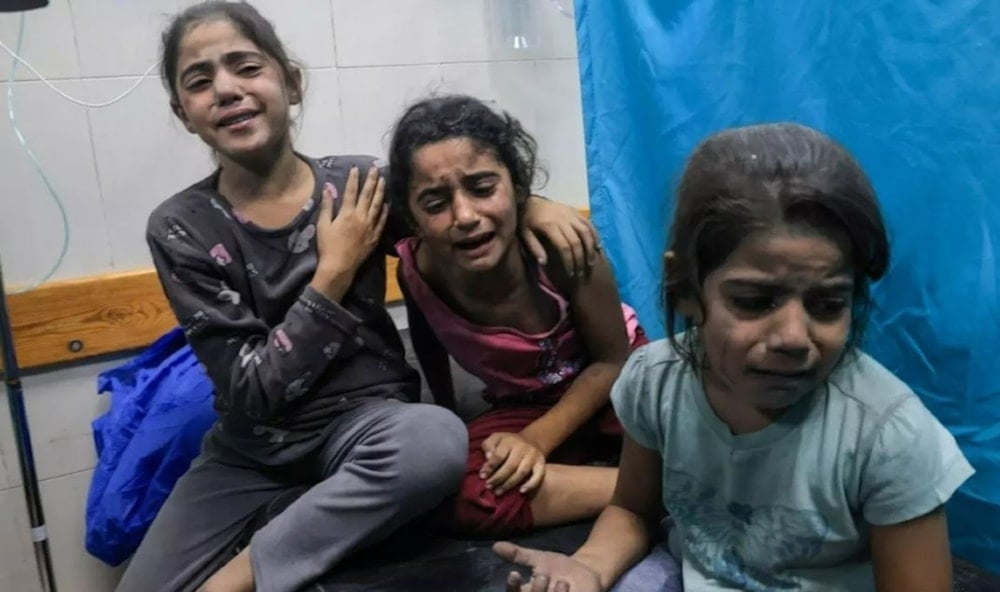Grim reality: Starvation grips Gaza as crisis deepens amid genocide
The vast majority of Gaza's 2.2 million inhabitants lack sufficient food, often skipping meals and occasionally enduring several days without any food, as per the World Food Programme.
-

Palestinian children injured in an Israeli airstrike await treatment at a hospital in southern Gaza on October 17, 2023. (AFP)
Gazans are confronting the specter of starvation for the first time in recent history, as reported by United Nations agencies. Aid deliveries have fallen short of the escalating needs in the enclave, resulting in a collapsed food supply system, The Wall Street Journal reported.
The report also highlighted that the vast majority of Gaza's 2.2 million inhabitants lack sufficient food, often skipping meals and occasionally enduring several days without any food, as per the World Food Programme.
The UN is currently evaluating whether Gaza meets the formal definition of famine, where two out of every 10,000 residents die from hunger each day, and roughly one in three children is acutely malnourished.
The situation in Gaza is dire as “Israel” is committing genocide against Palestinians in the Gaza Strip alongside a total blockade. In further detail, insufficient humanitarian aid entry is restricted to the Rafah border crossing with Egypt, and "Israel" monitors all incoming goods. It is worth noting that the government in Cairo has prevented Gazans from seeking refuge in Egypt.
"Israel" claimed to double the daily number of aid trucks entering Gaza, exceeding a capacity of 400 trucks, contingent on international organizations managing the increased aid distribution.
However, recent reports indicate that between 40 to 170 humanitarian aid trucks carrying insufficient aid have passed through the Rafah crossing. The blame game continues with "Israel" pointing fingers at the UN for the bottleneck, asserting that a second crossing should be opened, while the UN affirms that "Israel's" hindrances impede aid delivery in Gaza.
In the best-case scenario, this inadequate relief acts as a band-aid, but all too often, it is deployed inadequately and belatedly amid the ongoing genocide in Gaza. The act of besieging an already vulnerable territory exacerbates the damage, making any aid in the form of biscuits, water, and shrouds insufficient for adequate recovery. A humanitarian catastrophe is imminent, potentially resulting in the loss of thousands of lives.
The report added that the hunger crisis in northern Gaza is particularly severe, exacerbated by the Israeli military's extensive aggression on the Strip over the past two months. This region has been largely cut off from aid distribution, and nearly half of households there are experiencing severe levels of hunger, according to the World Food Programme.
Bombing, famine pushing Gazans to extremes
Many residents in Gaza are living in constant fear, grappling not only with the threat of bombs but also with the looming specter of starvation.
Hussam Abu Safiya, a pediatrician at a northern Gaza hospital, expressed the dire situation, stating that children cry from hunger and thirst, and the population is facing a slow and painful demise.
After two months of brutal Israeli aggression, Gaza's economy has virtually collapsed, with the World Bank estimating that 85% of the workforce is unemployed. The absence of commercial imports has led to the closure of numerous shops, and those still open struggle to replenish basic necessities like rice and cooking oil.
In southern Gaza, where a significant number of families were forcibly displaced from the north, half of the population is now entirely reliant on food handouts, as reported by the United Nations.
Prior to the current aggression, approximately half of Gaza's population received some form of food assistance, a situation partly resulting from the 16-year economic blockade imposed by "Israel".
In the current circumstances, meat and dairy products are virtually absent, and people primarily rely on limited quantities of cereals and potatoes.
The available food has become prohibitively expensive, with a 55-pound bag of flour costing $100, if it can be found. Fresh vegetables are scarce and now cost four times as much as they did before the war. Loai Mohammed, a 26-year-old displaced Gazan in Rafah, mentioned having a single meal of flatbread with cream cheese on Thursday.
“Our life is so hard,” said Mohammed, as quoted by WSJ. “Sometimes we eat, sometimes we don’t. It takes so much effort to get water and food.”
The ongoing aggression has significantly impacted local food production in Gaza, which previously met approximately 10% of the territory's needs. The disruptions are primarily attributed to shortages of water, energy, and animal feed, according to Maximo Torero, the chief economist at the Food and Agriculture Organization of the United Nations, as reported by WSJ.
"Gaza historically had significant problems, but the war is taking the situation to an extreme,” he added.
Presently, 85% of Gaza's population, equivalent to 1.9 million individuals, have been forced out of their residences. The majority of these forcibly displaced individuals are located in southern Gaza, where the crowded living conditions in homes and shelters have led to the onset of infectious diseases.
Read next: Masters of survival: Gaza's resilience amid genocide

 5 Min Read
5 Min Read









